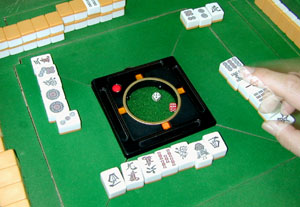The 2002 World Championship in Mahjong Comes to Tokyo
The Captain would never describe himself as a gambling man. The reason is simple: it is already taken for granted; from his part-time work as lead leak inspector at his local nuclear power plant to his late-night "chicken" contests with some of his colleagues on the subway tracks, the Captain's life is one big game of chance.
 At one time, the mahjong business was similar - assumed to be akin to gambling, that is. Today, mahjong is slowly shedding that image; it is a family game, a game of true competition. And this week Tokyo will be location for the 2002 World Championship in Mahjong. Join the Captain as he turns over a few tiles and discusses some of the recent developments in the image of this parlor pastime.
At one time, the mahjong business was similar - assumed to be akin to gambling, that is. Today, mahjong is slowly shedding that image; it is a family game, a game of true competition. And this week Tokyo will be location for the 2002 World Championship in Mahjong. Join the Captain as he turns over a few tiles and discusses some of the recent developments in the image of this parlor pastime.
Jong Rock rides a motorcycle and plays guitar. He's a tough guy; has long sideburns and a skull-painted leather jacket. The ladies can't resist him and he plays...mahjong.
Rock is the main character in a manga (comic) featured in Kindai Mahjong, a bi-monthly magazine whose content includes manga serials and advertising all focusing on the game of ceramic tiles on felt.
As a business, mahjong doesn't have the scope of pachinko, one of Japan's largest industries. Neither does it have quite the sophisticated allure of horse racing. Instead, its reputation over the past few decades has been as the game of choice for high-stakes wagering in smoke-filled backrooms and parlors by some of Japan's hardest-core gamblers - including members of the yakuza (gangsters), company presidents, and politicians.
But today, this image is slowly being changed. In its place is that of a friendly game, one whose appeal is as a means of leisure for average salarymen, retirees, and young people. And yes, even those inclined to read comic books, which is a significant amount of the population. Given this, the organizers of the 2002 World Championship in Mahjong, set to arrive in Tokyo this week, couldn't be happier.
"Mahjong has come to be understood as a sport and a competition at last," beams Kyoichiro Noguchi, Chairman of the Board of Directors of the Mahjong Museum and Director of the Japan Mahjong Organizing Committee.
This first ever championship, to be held at the Grand Palace Hotel in Iidabashi, will draw 120 players comprising 30 teams. Noguchi expects the strongest players to hail from China, Japan, the United States, Sweden, Hong Kong, and Holland.
 Ever since the game was imported to Japan from China over 100 years ago, Japanese players have developed their own rules. But the basics are the same. Players select individual hands of 13 small white Chinese character-covered tiles from a pool of 136. One player selects 14 - the starter of the game. The tiles come in matching sets of 4 and the goal is to create a hand of any of a number of predetermined matching combinations of tiles. Players take alternating turns in discarding and selecting tiles from the remaining pool until a player achieves a hand of one of the matching combinations, allowing him to "go out." Based on his exiting hand, points are then tallied.
Ever since the game was imported to Japan from China over 100 years ago, Japanese players have developed their own rules. But the basics are the same. Players select individual hands of 13 small white Chinese character-covered tiles from a pool of 136. One player selects 14 - the starter of the game. The tiles come in matching sets of 4 and the goal is to create a hand of any of a number of predetermined matching combinations of tiles. Players take alternating turns in discarding and selecting tiles from the remaining pool until a player achieves a hand of one of the matching combinations, allowing him to "go out." Based on his exiting hand, points are then tallied.
For the championship, the rules of play will be those set by the State Sports Commission of China in 1998 - the year that mahjong came to be recognized as an international sport.
Today, Japan is the home to over 20,000 parlors nationwide with nearly 5,000 in Tokyo and 2,000 in Osaka. They can be found in large entertainment districts or small residential communities.
The times of greatest activity are on Friday and Saturday nights for Tokyo parlors, often tucked in darkened alleys with signs out displaying the two Chinese characters that compose the game's name. At assistant manager Kensuke Saito's Vacance Mahjong in Kagurazaka, salarymen and students from universities in nearby Ochanomizu and Waseda can be found filling his parlor, steady streams of cigarette smoke rising from each table. This parlor, painted in a South Pacific island motif of seagulls, ocean waves, and palm trees, charges a rate of 1,000 yen per hour per table. Students get a break and are charged at rate of 500 yen.
Given the relatively low prices for playing, mahjong has become a popular option during the past decade of economic stagnation. Though Saito admits that his business is being influenced by Japan's weakened economy, he isn't worried because he has plenty of loyal customers. "Compared to hostess clubs," he says, "this is very cheap. We opened four years ago. The economy was already slow at that point."
Reikichi Sumiya, a journalist and yakuza expert, maintains that while the image of the game has changed, the yakuza and mahjong are still deeply linked. For many gangs, the game is used as a means of honoring members at times of a funeral or wedding.
 "There is a gambling party," Sumiya explains of these special times. "Suites are reserved at one of Tokyo's top hotels. There's tobacco, brandy, sake, bourbon, girls walking around, and mahjong."
"There is a gambling party," Sumiya explains of these special times. "Suites are reserved at one of Tokyo's top hotels. There's tobacco, brandy, sake, bourbon, girls walking around, and mahjong."
The players will strip to their waists to reveal their colorful tattoos just before the game is to begin. Since the games often drag on into late the next morning, they shoot up on speed to stay alert. "They use promissory notes because the wagering can exceed 1 billion yen," Sumiya says.
Further, last year's arson fire at a video mahjong parlor - suspected to be of mob origin and which killed 44 people in Tokyo's Kabukicho district, reinforced this gangster-associated image of the game.
But these are exceptions. Mahjong parlors are more and more being seen as a place to go and associate with other people for friendly competition. Additionally, women are being encouraged with lessons specifically for them being more readily available.
The game has even spawned a somewhat sultry side. Dozens of ads in Kindai Mahjong feature parlors that will provide hardly clad young ladies to play should you arrive with a party that includes less than the four people needed for a game.
Of these positive developments in the game, Noguchi says, "Nothing gives us such great pleasure as this."
Note: The 2002 World Championship in Mahjong will run from October 23rd through the 28th.

